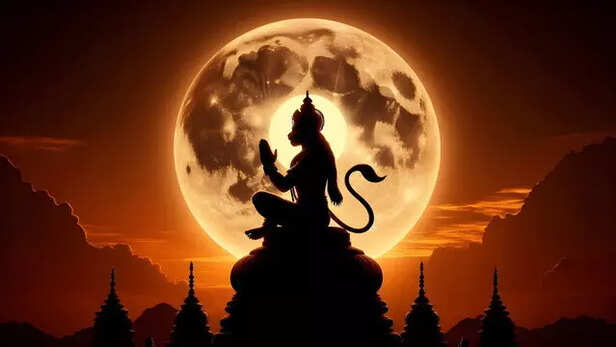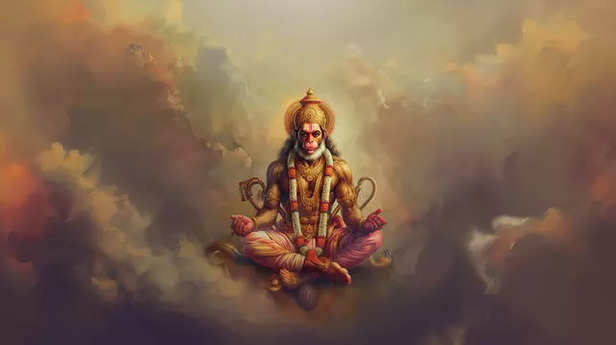What Are the DANGERS of Chanting Bajrang Baan?
Ankit Gupta | Apr 12, 2025, 12:10 IST
Lord Hanuman
The tone of the Bajrang Baan is intense, no doubt. That’s because it is meant to be used in urgent situations, when your soul is crying out for rescue. It is not casual recitation — but it is also not dangerous. Hanuman knows your heart. You cannot hide behind words. He sees your bhava — your inner emotion.
In recent times, a question has begun circulating across social media and spiritual circles — “Is it dangerous to chant the Bajrang Baan?” Many seekers and devotees are confused, worried, or hesitant about invoking this powerful hymn dedicated to Lord Hanuman.
Some claim that Bajrang Baan can backfire if chanted incorrectly or without proper initiation. Others suggest that it uses strong language or oaths that attempt to force Hanuman to act. So what’s the truth?
In this article, we will demystify the origins, purpose, and nature of the Bajrang Baan, address the concerns around it, and explain why such fear stems from misunderstanding — not scripture.

The Bajrang Baan is a revered prayer composed by Goswami Tulsidas, one of the greatest saints in Hindu tradition. The same Tulsidas who wrote the Hanuman Chalisa and the epic Ramcharitmanas, composed this hymn with deep reverence and intensity. The word "Baan" literally means arrow, and this hymn is like a spiritual missile — aimed at removing obstacles, negative forces, and inner disturbances.
Unlike other softer prayers, the Bajrang Baan carries an intense emotional charge — it is a cry for divine intervention, often used in times of crisis, mental stress, spiritual attack, or desperation.

One of the main reasons why some consider the Bajrang Baan dangerous is a particular line that reads:
"शपथ राम की राखु पानि, भागि जात मइँ सत्य जानी।।"
(I take the oath of Shri Ram, protect my honor, otherwise I will run away — this is the truth.)
This is seen by some as a way of commanding or forcing Hanuman to act.
But this interpretation is flawed.
Let’s reflect — can anyone really force Hanuman, the eternal celibate, the possessor of unimaginable strength, wisdom, and divine insight, to act?
Hanuman is not a servant of compulsion, but a servant of devotion. He is Bhakta Shiromani, the crown of all devotees. The use of such language in the Bajrang Baan is not an attempt to control Hanuman, but rather an expression of the desperation and vulnerability of a devotee who is drowning and cries out for help.
It is a poetic device, not a threat.
There is a popular myth that chanting Bajrang Baan can bring misfortune or harm if done incorrectly or casually.
This fear comes from a half-baked understanding of Tantric practices. In certain lower-level occult traditions, some mantras are used to bind or manipulate spirits for selfish gains like Vashikaran (attraction), Marana (harm), or Ucchatana (disturbance). Such rituals often require strict rules, initiations, and can have negative consequences if misused.
But the Bajrang Baan is NOT Tantra.
It is a stotra, a devotional hymn.
And Hanuman is not a controllable spirit, but a divine deity, a Mahavira, a Vajra Yogi who sees beyond the words into the bhava (emotion) of the chanter.
Therefore, chanting Bajrang Baan with ego, arrogance, or casualness may indeed bring disturbance — not because Hanuman punishes you, but because your own inner energy becomes chaotic when approached without reverence.
But if you chant it with shraddha (faith), prema (love), and samarpan (surrender), it can bring immense spiritual power and protection.
Another fear arises due to the presence of Beej Aksharas — powerful seed syllables — in the Bajrang Baan. Words like “Raam Raam”, “Hoon Hoon”, and “Phat Phat” are commonly mistaken for tantric mantras requiring initiation (Diksha).
Let’s clarify:
Beej Aksharas amplify energy, but they are not forbidden. You don’t need a guru’s formal initiation to chant Bajrang Baan. What you need is purity of intent and a clean heart.
The danger is not in the words —
The danger is in chanting them mechanically or without understanding their purpose.
When approached with awareness, these syllables can cut through negative influences, clear mental fog, and energize your aura.

If Bajrang Baan was so dangerous, why would Goswami Tulsidas — one of the most elevated saints in history — compose it?
In his own words, Tulsidas says that one who chants the Bajrang Baan with true faith and love will find success and protection in all endeavors, through the grace of Hanuman.
He never warned against its use. In fact, he encouraged seekers to use it in times of need — not as a shortcut, but as an act of surrender.
So let us trust the intent of the saint more than the confusion of the internet.
Here’s how to approach Bajrang Baan safely and powerfully:
You may chant it:

The only real danger is chanting sacred texts without humility, without understanding, or for selfish gain.
Hanuman cannot be “forced.”
He cannot be “controlled.”
But he always responds to love. He always answers a genuine cry for help.
In the Bajrang Baan, you are not commanding Hanuman —
You are surrendering to him.
So yes — chant it.
But chant it with faith, devotion, and respect.
And let Hanuman do the rest.
Victory to the ocean of wisdom and strength!
May his grace protect all sincere seekers on the path of truth.
Some claim that Bajrang Baan can backfire if chanted incorrectly or without proper initiation. Others suggest that it uses strong language or oaths that attempt to force Hanuman to act. So what’s the truth?
In this article, we will demystify the origins, purpose, and nature of the Bajrang Baan, address the concerns around it, and explain why such fear stems from misunderstanding — not scripture.
Understanding Bajrang Baan

Shadows
The Bajrang Baan is a revered prayer composed by Goswami Tulsidas, one of the greatest saints in Hindu tradition. The same Tulsidas who wrote the Hanuman Chalisa and the epic Ramcharitmanas, composed this hymn with deep reverence and intensity. The word "Baan" literally means arrow, and this hymn is like a spiritual missile — aimed at removing obstacles, negative forces, and inner disturbances.
Unlike other softer prayers, the Bajrang Baan carries an intense emotional charge — it is a cry for divine intervention, often used in times of crisis, mental stress, spiritual attack, or desperation.
The Source of Fear: “Shapath Ram Ki”

Shri Ram and Hanuman
One of the main reasons why some consider the Bajrang Baan dangerous is a particular line that reads:
"शपथ राम की राखु पानि, भागि जात मइँ सत्य जानी।।"
(I take the oath of Shri Ram, protect my honor, otherwise I will run away — this is the truth.)
This is seen by some as a way of commanding or forcing Hanuman to act.
But this interpretation is flawed.
Let’s reflect — can anyone really force Hanuman, the eternal celibate, the possessor of unimaginable strength, wisdom, and divine insight, to act?
Hanuman is not a servant of compulsion, but a servant of devotion. He is Bhakta Shiromani, the crown of all devotees. The use of such language in the Bajrang Baan is not an attempt to control Hanuman, but rather an expression of the desperation and vulnerability of a devotee who is drowning and cries out for help.
It is a poetic device, not a threat.
Can Bajrang Baan Backfire?
This fear comes from a half-baked understanding of Tantric practices. In certain lower-level occult traditions, some mantras are used to bind or manipulate spirits for selfish gains like Vashikaran (attraction), Marana (harm), or Ucchatana (disturbance). Such rituals often require strict rules, initiations, and can have negative consequences if misused.
But the Bajrang Baan is NOT Tantra.
It is a stotra, a devotional hymn.
And Hanuman is not a controllable spirit, but a divine deity, a Mahavira, a Vajra Yogi who sees beyond the words into the bhava (emotion) of the chanter.
Therefore, chanting Bajrang Baan with ego, arrogance, or casualness may indeed bring disturbance — not because Hanuman punishes you, but because your own inner energy becomes chaotic when approached without reverence.
But if you chant it with shraddha (faith), prema (love), and samarpan (surrender), it can bring immense spiritual power and protection.
The Role of Beej Aksharas and the Myth of Initiation
Let’s clarify:
Beej Aksharas amplify energy, but they are not forbidden. You don’t need a guru’s formal initiation to chant Bajrang Baan. What you need is purity of intent and a clean heart.
The danger is not in the words —
The danger is in chanting them mechanically or without understanding their purpose.
When approached with awareness, these syllables can cut through negative influences, clear mental fog, and energize your aura.
What Did Tulsidas Himself Say?

Tulsidas
If Bajrang Baan was so dangerous, why would Goswami Tulsidas — one of the most elevated saints in history — compose it?
In his own words, Tulsidas says that one who chants the Bajrang Baan with true faith and love will find success and protection in all endeavors, through the grace of Hanuman.
He never warned against its use. In fact, he encouraged seekers to use it in times of need — not as a shortcut, but as an act of surrender.
So let us trust the intent of the saint more than the confusion of the internet.
The Right Way to Chant Bajrang Baan
- Cleanse Yourself: Take a bath, light a diya, and sit in a quiet space.
- Create Sankalpa (Intention): Chant for healing, strength, or spiritual upliftment — not for revenge or manipulation.
- Chant with Bhakti: Don’t rush through. Feel every word. Visualize Hanuman’s presence.
- Let Go of Fear: Hanuman is Karunamayi — the embodiment of compassion. He knows your sincerity.
- Observe Results, but Detach: Chant with trust, but don’t fixate on outcomes. Leave it to Hanuman.
When Should One Chant Bajrang Baan?
- When surrounded by negative thoughts or energies
- During intense emotional pain or loss
- If you’re facing betrayal, fear, or spiritual confusion
- When feeling mentally disturbed, anxious, or oppressed
- When you seek divine protection or intervention
It Is Not Bajrang Baan That Is Dangerous — It Is Ego

Divine Aura
The only real danger is chanting sacred texts without humility, without understanding, or for selfish gain.
Hanuman cannot be “forced.”
He cannot be “controlled.”
But he always responds to love. He always answers a genuine cry for help.
In the Bajrang Baan, you are not commanding Hanuman —
You are surrendering to him.
So yes — chant it.
But chant it with faith, devotion, and respect.
And let Hanuman do the rest.
Jai Hanuman Gyan Gun Sagar!
May his grace protect all sincere seekers on the path of truth.
